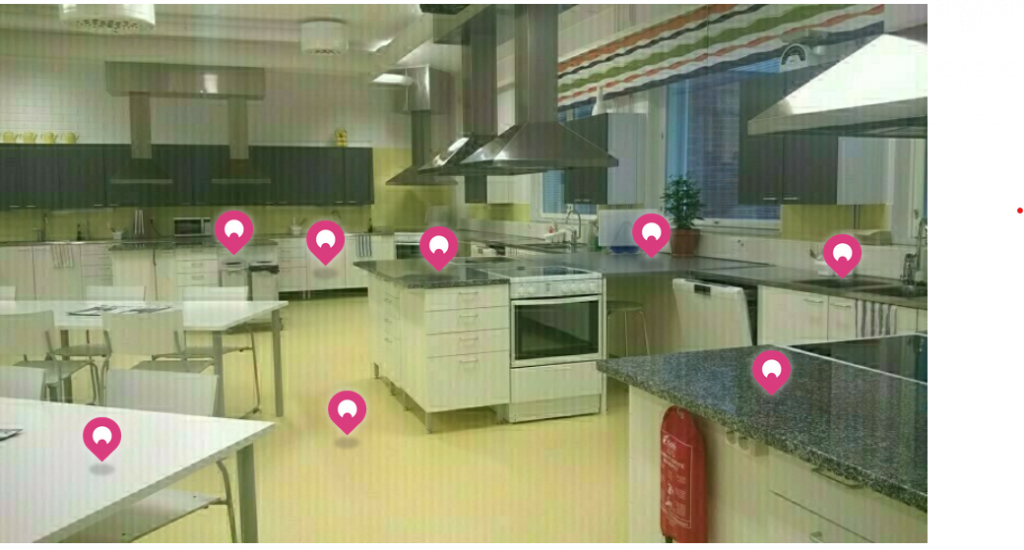Hoffren Noora, Huhtala Sinna, Laukkanen Silja & Myyryläinen Roope
Introduction
This blogpost is part of our home economics master’s degree course “Teacher as a researcher of one’s job” in which we did a small teaching experiment by using modern digital tools. Our groups teaching experiment took part in Finnish junior high school on total of three classes of which two where 8th grades and one of 9th grade. Our experiments topic was sanitation and hygiene which is part of home economics Finnish national core curriculum (S2) (POPS, 2014). Teaching experiment was put into practice by using distance learning methods in a way where the classes were in their own classroom with their own teacher but we as teachers of this experiment communicated with them from a distance by using Google Meets. The main aspect of our teaching experiment was to teach by using digitality and gamification. We made our own game about sanitation and hygiene by using game designing platform called Seppo. Sadly we made our game with 30 days try out license, so we are not able to share a link to the actual game. Besides Seppo we also used two different digital tools, Classroomscreen and Google Forms, as part of our experiment. Classroomscreen worked out as an app which we used to show the students different QR-codes to the game, the source of information about hygiene and the Google Forms which we used for getting feedback from the students. Through Classroomscreen we also showed our faces to the students to improve interaction.

By Laukkanen Silja
Background
Background for our teaching experiment and planning of it based on conception of learning called sociocultural constructivism which is considered to be developed by Lev Vygotski. In sociocultural constructivism learning is seen as social and cultural as well as communal processes and phenomena. Which means that knowledge can’t just be given to students, they must understand and build it themselves and it is their responsibility to learn. Sociocultural constructivism also emphasizes on students deeper understanding of things and phenomena rather than just memorizing facts. As the base of our ideas about sociocultural constructivism we used Siljanders (2014) book “Systematic leading to education theory”. When teaching in sociocultural constructive way teachers’ responsibility is to provide learning environment, help with the right information acquisition and to assist with independent studying. In this teaching experiment we used method called flipped learning. In this case it was done by giving the students homework in advance to study our experiments topic. Studying topic in advance makes it possible for our experiment to rehearse already learned knowledge and build new on it. This way responsibility of learning is given to students themselves and studying is focusing on students to become more independent of their learning.
In addition to sociocultural constructivism and flipped learning our teaching experiment also based strongly on digitality and gamification. Teaching and learning took part mostly on digital learning environment. Which was combination of four different digital applications, Seppo, Classroomscreen, Google Forms and Google Meets. Besides digital learning environment students also took part in physical learning environment in their own classroom with their own home economics teacher who helped them from closer contact. Combination of physical and digital learning environments made it possible for the students to have better interaction with the teachers and between themselves. When teaching in digital environment from a distance it is important to make interaction possible, separate learning from totally independent learning and have different kinds of assignments that consist written data, pictures, and voice to allow different kind of learners to understand and create learning experiences. (Rantanen & Palojoki, 2015.) Main reason for our teaching with gamification was to see how it motivates and inspires students to learn new things. Through gamification it is possible to provide learning in interesting and fun form and it works as good motivational base for learning. One motivational element of games is getting points and instant positive feedback which keeps students’ motivation high while playing. When using gamification in teaching it is important to pay attention to difficulty of the game. If the game is too easy or too hard it may extinguish students’ motivation towards the game on learning.
Teaching experiment
Our goals in our teaching experiment were aimed towards both the students and for ourselves. During this course we wanted to improve our skills working and teaching in group. We also wanted to learn about new ways and platforms of distance teaching and try some of them in practice because this was first time of distance teaching for most of us. Our goal for our teaching experiment was to create motivational and inspirational learning task and lesson for highly theoretical topic. We also wanted to focus on achieving good interaction with the students’ even though we were not physically in the same place with them. What we wanted the students’ get from this experience were to improve their interaction skills, learn how to find and build new knowledge and to learn about the sanitation and hygiene which was the main topic of the lesson. (POPS, 2014.)
Teaching experiment started with 8th graders on Monday morning. First, we introduced ourselves to the students and then gave them instructions about the lesson. After instructions we gave students permission to start playing Seppo game. Our Seppo game consisted of eight different little tasks and missions about sanitation and hygiene. For example, we had tasks about dishwashing, cleaning tools and identifying pests. During gaming students got instant feedback and points from the games alongside feedback from us through chat and some of the tasks. After first lesson we were pretty happy about how it went although we noticed some little things that we should improve for our next lesson. For next lesson modified our Classroomscreen to be easier to understand and we decided to emphasize chat more for the next group so we can interact better with the students. We also decided to make ninth task to the game because their teacher told us that they are really capable group. We also changed the size of groups, where students play the game, to pairs from previous groups of four. This way we managed to get students to take part in the game better. During the second lesson we had better interaction with the students through chat and we also noticed that the pairs work better than little groups. After second lesson we took the extra task away from the game because last lesson was going to be on Friday evening and the students would be little bit tired already. We also added picture of Seppo Taalasmaa from Salatut Elämät television series to Classroomscreen as we thought we would motivate the students to study with little bit humour.

By Laukkanen Silja
After getting feedback about the experiment from students and their teacher together with our own feelings we felt that our experiment was success. Based on feedback from the students’ 83 percent of them thought that the lesson was either interesting, okay or they learned something new. Only 17% percent of the students’ thoughts that the experiment was boring. We also thought that our teaching with gamification and flipped learning really worked because most of the students did very well in different tasks and were really self-oriented towards looking for knowledge. In our opinion important factor for our experiment to be successful was that the students were in their classroom together with their teacher and that made learning and interaction work a lot better. If the experiment would have been done totally distantly we think that it would not have worked so well because it would have lacked great amount of students interaction among each other.

By Laukkanen Silja
References
Peruskoulun opetussuunnitelman perusteet [POPS] (2014). Helsinki: Opetushallitus.
Rantanen, M. & Palojoki, P. (2015). Kotitalous verkko-opetuksena. Teoksessa H. Janhonen-Abruquah & P. Palojoki (toim.), Luova ja vastuullinen kotitalousopetus. Creative and responsible home economics education (s. 73–94). Helsinki: Unigrafia.
Siljander, P. (2014). Systemaattinen johdatus kasvatustieteeseen. Peruskäsitteet ja pääsuuntaukset. Tampere: Vastapaino.
